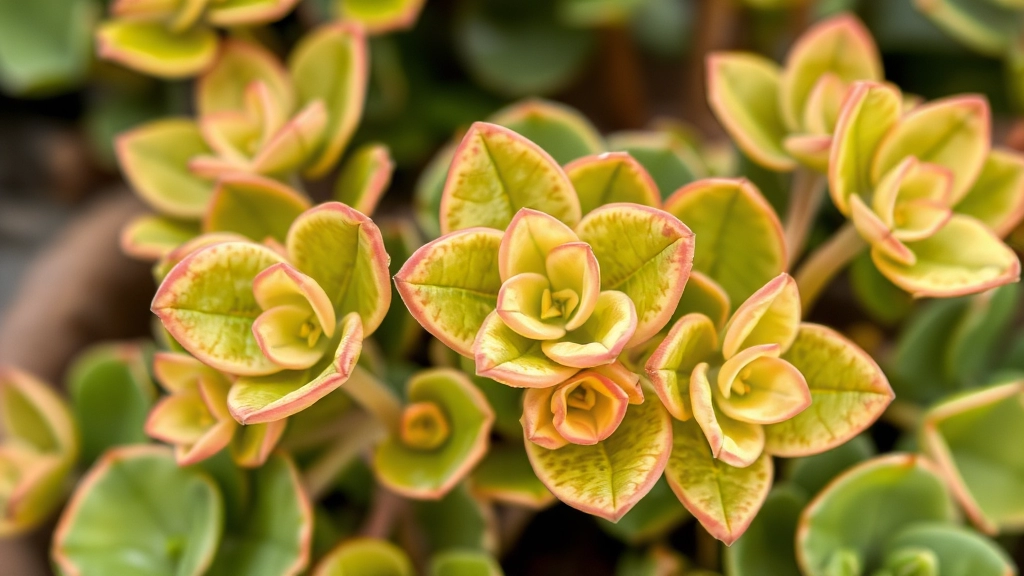Understanding Kalanchoe Leaf Softness
Ever noticed your Kalanchoe leaves turning soft and wondered what’s going wrong? You’re not alone. This common issue usually boils down to improper watering, temperature fluctuations, or nutrient deficiencies. Let’s dive into these potential causes and how you can get your plant back to its healthy, vibrant self.
Common Causes of Soft Leaves
First off, overwatering is a major culprit. Kalanchoe plants thrive in well-drained soil, and too much water can lead to root rot, making the leaves soft and mushy. On the flip side, underwatering can also stress the plant, causing the leaves to lose their firmness.
Environmental Factors
Temperature and humidity levels also play a crucial role, as Kalanchoe prefers a stable, warm environment. Keep an eye on these factors, and you’ll be well on your way to solving the mystery of those soft leaves.
Common Reasons for Soft Kalanchoe Leaves
Are your Kalanchoe leaves looking limp and soft? You’re not alone in this concern. Many plant enthusiasts face this issue, and understanding the common reasons behind it can set you on the right path to revitalising your plant.
Soft leaves on Kalanchoe can be attributed to several factors, including:
- Overwatering: This is often the primary culprit. Kalanchoe plants thrive in well-draining soil, and excess moisture can lead to a host of problems. For detailed care tips, check out our Kalanchoe Tomentosa watering guide.
- Underwatering: Surprisingly, not providing enough water can also cause leaves to soften. Kalanchoe needs consistent moisture, especially during its growing season.
- Nutrient Deficiencies: A lack of essential nutrients can weaken the plant, leading to soft and unhealthy leaves. Learn more about common Kalanchoe leaf problems and their solutions.
- Temperature and Humidity: Kalanchoe prefers a stable environment. Sudden changes in temperature or humidity can stress the plant, resulting in soft leaves.
- Root Rot: This often goes hand-in-hand with overwatering. If the roots are damaged, the plant can’t take up water efficiently, leading to wilting leaves.
Recognising these factors early can help you take corrective action swiftly.
Identifying Overwatering in Kalanchoe
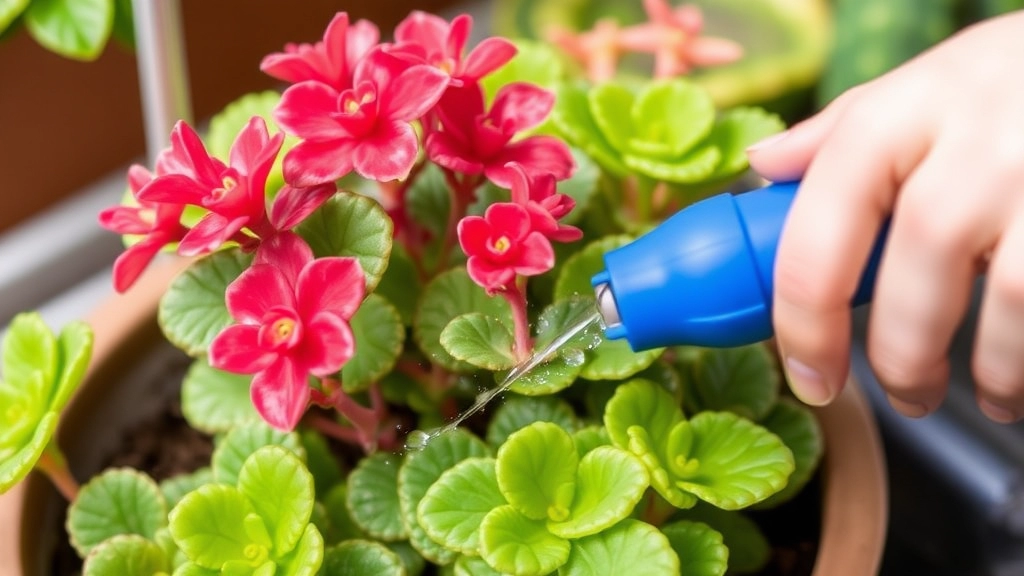
Have you noticed your Kalanchoe leaves looking a bit soft and droopy? You might be dealing with overwatering, a common issue that can sneak up on even the most seasoned plant lovers.
Signs of Overwatering
- Yellowing Leaves: If your Kalanchoe’s leaves are turning yellow, it’s a big red flag.
- Soft, Mushy Texture: Healthy leaves should feel firm. If they’re squishy, you’ve got a problem.
- Drooping: Leaves that hang down instead of standing tall could be gasping for air—literally.
- Wet Soil: If the soil feels soggy and doesn’t dry out between waterings, you’re likely overdoing it.
What Causes Overwatering?
- Poor Drainage: Make sure your pot has drainage holes. If water can’t escape, it’ll pool at the bottom, leading to root issues.
- Too Frequent Watering: Kalanchoes prefer to dry out a bit between drinks. Watering too often can drown them.
- Humidity Levels: High humidity can retain moisture in the soil longer than you think.
Quick Fixes
- Check the Soil: Stick your finger in the soil. If it’s still wet a couple of inches down, hold off on watering.
- Repot: If you suspect root rot, consider repotting your plant in fresh, dry soil.
- Adjust Your Watering Schedule: A good rule of thumb is to water when the top inch of soil feels dry.
Effects of Underwatering on Kalanchoe Health
Have you ever noticed your Kalanchoe leaves drooping or appearing shrivelled?
Underwatering can be just as detrimental as overwatering, and it often goes unnoticed until significant damage occurs.
When Kalanchoe plants don’t receive enough water, they exhibit several telltale signs that signal distress.
Temperature and Humidity Factors Affecting Kalanchoe
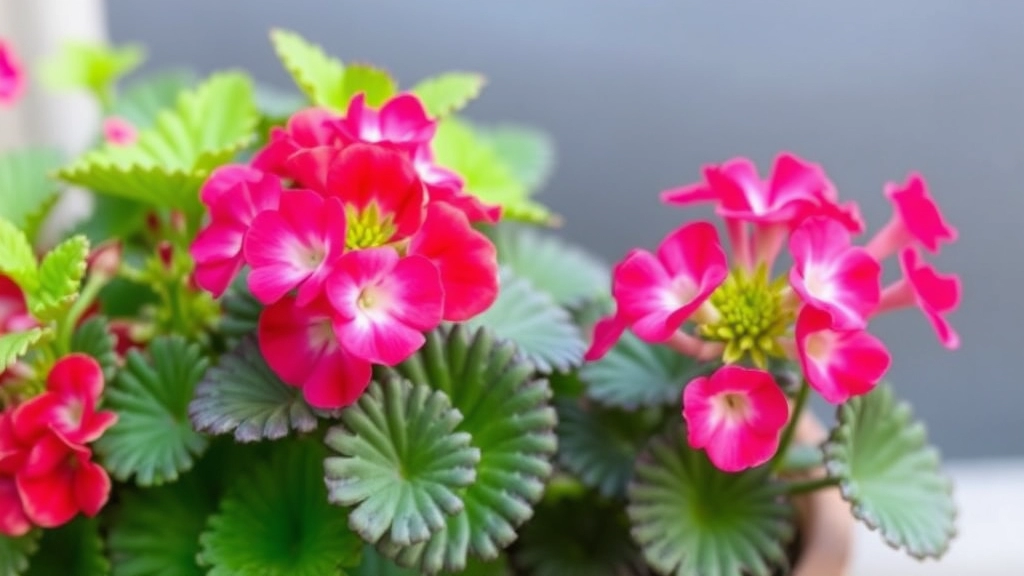
Have you noticed your Kalanchoe leaves becoming soft and limp?
Temperature and humidity are crucial factors that can significantly impact the health of your plant.
Ideal Temperature Range
Kalanchoe thrives in a warm environment.
- Optimal Range: 20°C to 25°C (68°F to 77°F) during the day.
- Nighttime: A slight drop to around 15°C to 18°C (59°F to 64°F) is acceptable.
Extreme temperatures can stress your plant, leading to soft leaves.
Humidity Levels
Kalanchoe prefers moderate humidity levels.
- Ideal Humidity: 40% to 60% is best for healthy growth.
- Too Low: If humidity drops below 30%, leaves may become dry and soft.
- Too High: Excess humidity can lead to fungal issues.
Signs of Temperature and Humidity Stress
Keep an eye out for these indicators:
- Soft, Limp Leaves: Often a sign of both overwatering and unsuitable temperature.
- Leaf Drop: A response to sudden temperature changes.
- Wilting: Can indicate low humidity or extreme heat.
Tips for Maintaining Ideal Conditions
To ensure your Kalanchoe stays happy:
- Location: Place it in a warm, bright spot away from drafts.
- Humidity Control: Use a humidifier or pebble tray to maintain moisture.
- Temperature Monitoring: Keep an eye on temperature fluctuations, especially in winter.
Nutrient Deficiencies and Their Impact on Kalanchoe Leaves
Have you ever noticed your Kalanchoe leaves looking less vibrant than usual?
Nutrient deficiencies can be a significant factor affecting the health of your plant.
When Kalanchoe lacks essential nutrients, it can lead to soft, discoloured leaves that may eventually fall off.
Signs of Root Rot in Kalanchoe Plants
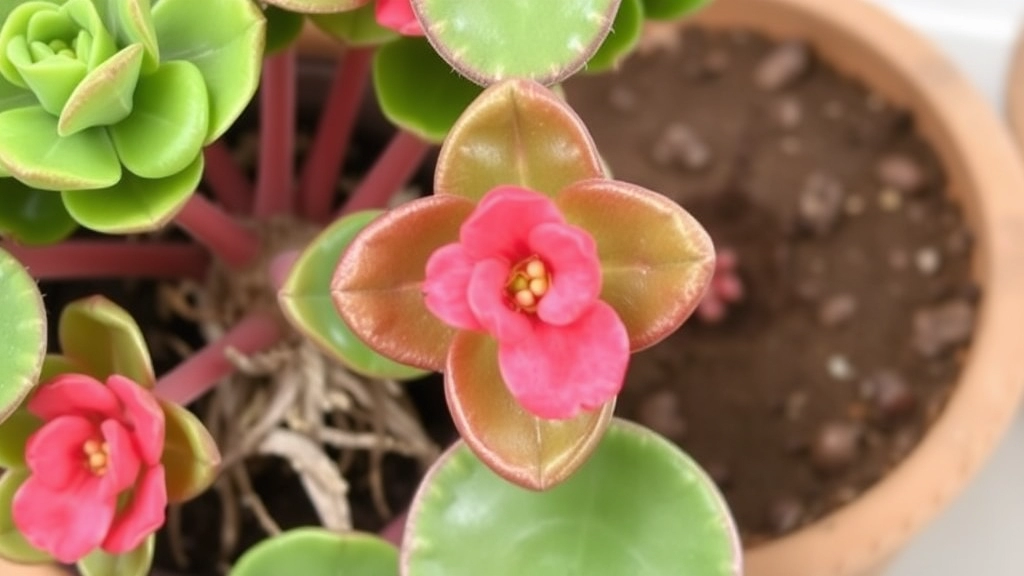
So, you’ve noticed your Kalanchoe leaves looking soft and sad, and you’re starting to worry. One major culprit could be root rot. It’s a sneaky issue that can sneak up on even the most seasoned plant parents. Let’s dive into the signs you should be on the lookout for.
Common Signs of Root Rot
- Discoloration of Leaves
If your once vibrant Kalanchoe leaves are turning yellow or brown, it’s a red flag. This change often indicates that the roots are struggling. - Soft, Mushy Stems
Give your plant a gentle squeeze. If the stems feel squishy, this is a sure sign that rot is setting in. - Foul Odour
A pungent smell coming from the soil is a telltale sign of root rot. It’s not just unpleasant; it’s a signal that your plant is in trouble. - Stunted Growth
If your Kalanchoe isn’t growing as it should or seems to have stalled, root rot might be the reason. Healthy roots are essential for nutrient uptake. - Wilting Despite Moist Soil
If the soil feels wet yet your plant looks droopy, it’s time to investigate. This often means the roots are unable to absorb water properly.
What to Do If You Suspect Root Rot
- Check the Soil
Dig a little to see if it’s soggy. If it is, you might need to repot with fresh, dry soil. - Inspect the Roots
Gently remove the plant from its pot and look at the roots. Healthy roots are white and firm, while rotting roots will be brown and mushy. - Prune Affected Roots
If you find any rotten roots, cut them away with clean scissors. This helps prevent the spread of rot. - Repot
After trimming, repot your Kalanchoe in fresh soil. Make sure the pot has good drainage to avoid future issues. - Adjust Watering Habits
Going forward, let the soil dry out between waterings. This will help keep root rot at bay.
Root rot can be a tricky challenge, but don’t worry! With the right steps, you can bring your Kalanchoe back to life.
How to Properly Water Your Kalanchoe
Understanding how to properly water your Kalanchoe is essential for maintaining its health and preventing soft leaves. Many plant owners worry about overwatering or underwatering, which can lead to various issues.
Key Watering Guidelines
To keep your Kalanchoe thriving, consider the following tips:
- Check the Soil: Before watering, always check the top inch of soil. If it feels dry, it’s time to water.
- Use Well-Draining Soil: Ensure your Kalanchoe is planted in a potting mix designed for succulents. This helps prevent water retention.
- Water Thoroughly: When watering, do so until water drains out of the bottom of the pot. This ensures the roots receive adequate moisture.
- Frequency: Water your Kalanchoe every 2-3 weeks during the growing season (spring and summer). Reduce watering in the dormant months (fall and winter).
- Avoid Water on Leaves: Try to keep water off the leaves to prevent rot and fungal issues.
Signs of Proper Watering
After watering your Kalanchoe, watch for these signs that indicate you’re doing it right:
- Firm, plump leaves
- Vibrant colour
- Steady growth
Common Mistakes to Avoid
- Overwatering: This is the most common mistake. Always err on the side of caution.
- Ignoring Seasonal Changes: Your watering schedule should adapt with the seasons.
By following these straightforward guidelines, you’ll ensure your Kalanchoe receives just the right amount of water it needs to flourish. If you notice any issues such as soft leaves, you may want to explore the causes and solutions for why Kalanchoe leaves turn soft. Additionally, for those growing Kalanchoe in Hawaii, specific care tips might be beneficial to consider.
Adjusting Kalanchoe Care for Seasonal Changes
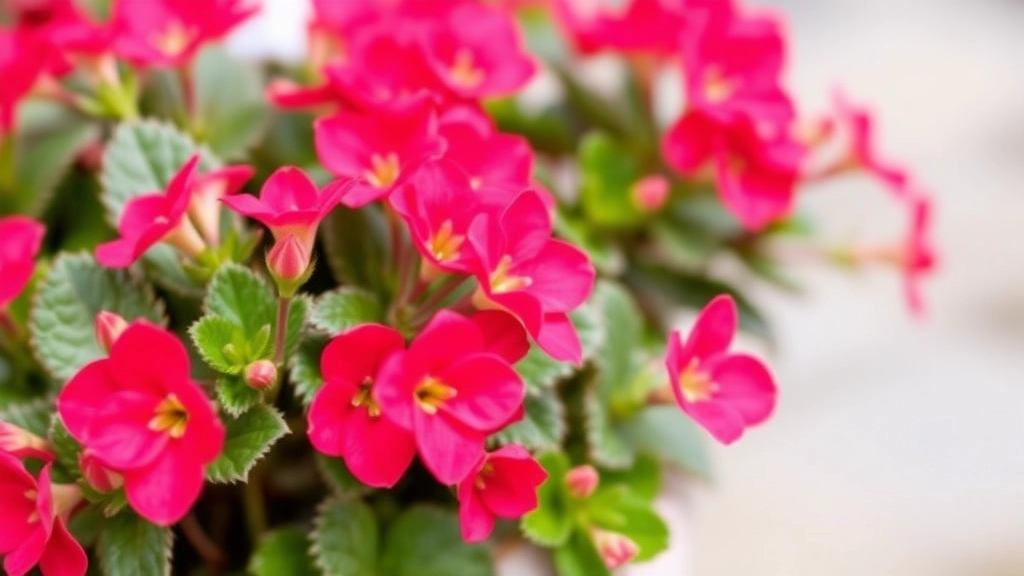
Ever noticed how your Kalanchoe seems to change with the seasons?
It’s not just you; plants respond to their environment.
As the weather shifts, so should your care routine.
Here’s how to keep your Kalanchoe thriving, no matter the season:
Spring and Summer Care
- Light: Kalanchoes love bright, indirect sunlight. During these warmer months, place them in a spot where they can soak up that sun.
- Watering: The warmer weather means your plant will need more water. Check the soil regularly—if the top inch is dry, it’s time to water.
- Humidity: Kalanchoes prefer drier air. If you live in a humid area, ensure good airflow around your plant to prevent issues.
Fall and Winter Care
- Light: Days get shorter, so you might need to move your Kalanchoe closer to a window to ensure it gets enough light.
- Watering: Cut back on watering. The cooler temperatures mean your plant won’t use as much water. Always check the soil before watering.
- Temperature: Kalanchoes enjoy warmth, so keep them in a spot that stays above 10°C (50°F). Avoid cold drafts that could stress them out.
General Tips
- Observe Changes: Keep an eye on your plant. If you notice soft leaves, it might be trying to tell you something about its care.
- Adjust Fertilization: Fertilize more in the growing season and less in the dormant months.
Preventing Soft Leaves Through Balanced Fertilization
Have you ever noticed your Kalanchoe leaves turning soft and limp? It can be disheartening to see your plant struggle, but the right fertilization can make all the difference.
Understanding Fertilization Needs
Kalanchoe plants thrive with proper nutrients, and a balanced fertilization routine is essential to keep their leaves firm and healthy.
- Choose the Right Fertilizer: Look for a balanced, water-soluble fertilizer with equal parts nitrogen, phosphorus, and potassium (N-P-K). This promotes overall plant health.
- Frequency: Fertilize every four to six weeks during the growing season (spring and summer) and reduce frequency in the dormant months (autumn and winter).
- Dilution: Always dilute your fertilizer to half the recommended strength to avoid nutrient burn, which can lead to soft leaves.
Signs of Nutrient Imbalance
Keep an eye on your Kalanchoe for signs of nutrient deficiencies:
- Yellowing Leaves: This may indicate a lack of nitrogen.
- Stunted Growth: If your plant isn’t growing as expected, it might need more phosphorus.
- Leaf Drop: This could signal a potassium deficiency.
By addressing these signs promptly, you can maintain the health of your Kalanchoe and prevent those dreaded soft leaves.
Real-Life Example
I once had a Kalanchoe that seemed to droop despite regular watering. After some investigation, I realised I hadn’t fertilized it in months. Once I introduced a balanced fertilizer into its care routine, the leaves perked up beautifully.
If you are looking for more detailed care instructions, check out this complete guide to Kalanchoe plant care. Additionally, if your Kalanchoe leaves are turning red, it might be a sign of other issues; learn more about it here.
Monitoring and Correcting Environmental Conditions
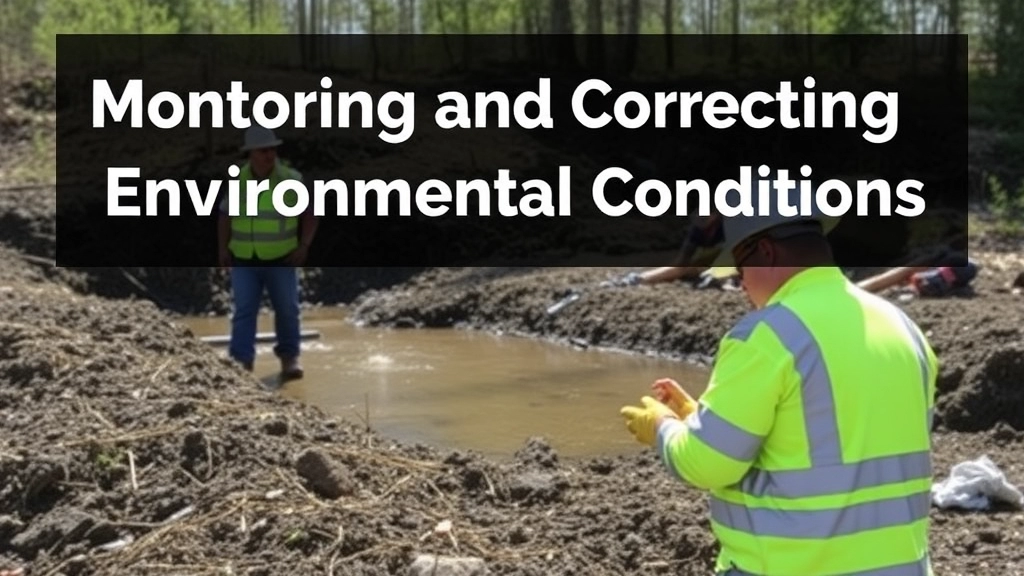
Have you ever noticed your Kalanchoe looking a bit sad, despite your best care efforts?
Well, environmental conditions can play a massive role in your plant’s health.
Temperature and Humidity
Kalanchoes thrive in warm, dry environments. Here’s what you should keep an eye on:
- Ideal Temperature: Aim for 20-25°C (68-77°F) during the day and slightly cooler at night.
- Humidity Levels: They prefer low humidity. If your home is too humid, consider using a dehumidifier.
Light Requirements
These plants love bright, indirect sunlight. If they’re not getting enough light, their leaves may start to soften.
- Placement Tips:
- Near a south-facing window is often best.
- If you notice leggy growth, it’s a sign they need more light.
Air Circulation
Good airflow helps prevent issues like mould and pests.
- Ensure your Kalanchoe is not cramped between other plants.
- A small fan can help circulate air if needed.
Correcting Conditions
If you spot any issues, here’s how to adjust:
- For Low Light: Move your plant to a brighter spot gradually to avoid shock.
- For High Humidity: Try relocating it to a drier area or using a fan.
Reviving a Kalanchoe With Soft, Wilting Leaves
Have you noticed your Kalanchoe’s leaves becoming soft and wilting? This can be distressing, but don’t worryâreviving your plant is possible with a few careful steps.
Assess the Situation
First, identify the cause of the wilting.
- Overwatering: Check for soggy soil or waterlogged roots.
- Underwatering: Feel the soil; it should be slightly dry but not parched.
- Temperature: Ensure it’s not too cold or hot for your Kalanchoe.
Steps to Revive Your Kalanchoe
- Adjust Watering:
- If overwatered, allow the soil to dry out completely before watering again.
- If underwatered, give it a good soak, ensuring excess water drains away.
- Inspect for Root Rot:
- Gently remove the plant from its pot and check the roots.
- Healthy roots are firm and white; brown, mushy roots indicate rot.
- Repot if Necessary:
- If you find root rot, trim away the affected roots and repot in fresh, well-draining soil.
- Provide Proper Light:
- Place your Kalanchoe in bright, indirect sunlight. Avoid harsh direct light that can scorch its leaves.
- Adjust Humidity and Temperature:
- Keep your plant in a room with moderate humidity and temperatures between 15°C and 24°C.
Monitor Progress
After taking these steps, keep an eye on your Kalanchoe. Look for signs of new growth, which indicate recovery. Be patient; it may take some time for your plant to bounce back.
For more detailed information on how to care for your Kalanchoe, check out our ultimate guide to Kalanchoe care. If you notice your Kalanchoe’s leaves turning brown, you might also find our article on causes and solutions for brown leaves helpful.
FAQs About Kalanchoe Leaves Turning Soft
Why are my Kalanchoe leaves turning soft?
Soft leaves in Kalanchoe plants can be a sign of various issues, including overwatering, unsuitable temperature, high humidity, or root rot. It’s important to identify the specific cause to address the problem effectively.
How can I tell if I’m overwatering my Kalanchoe?
Signs of overwatering include yellowing leaves, a soft and mushy texture, drooping leaves, and consistently wet soil. These symptoms indicate that the plant is receiving too much water and may be at risk of root rot.
What is the ideal temperature range for Kalanchoe plants?
Kalanchoe thrives in a warm environment with daytime temperatures between 20°C to 25°C (68°F to 77°F) and nighttime temperatures around 15°C to 18°C (59°F to 64°F). Extreme temperatures can stress the plant and lead to soft leaves.
How does humidity affect Kalanchoe plants?
Kalanchoe prefers moderate humidity levels of 40% to 60%. Low humidity can cause leaves to become dry and soft, while high humidity can lead to fungal issues and other problems.
What are the signs of root rot in Kalanchoe plants?
Common signs of root rot include discoloration of leaves (yellow or brown), soft and mushy stems, a foul odor from the soil, stunted growth, and wilting despite moist soil. These symptoms indicate that the roots are struggling and may be rotting.
How can I fix root rot in my Kalanchoe?
To address root rot, check the soil for sogginess, inspect the roots for health, prune any affected roots, and repot the plant in fresh, dry soil with good drainage. Adjust your watering habits to allow the soil to dry out between waterings.
How should I adjust Kalanchoe care for different seasons?
In spring and summer, provide bright, indirect sunlight and water more frequently as the weather warms. In fall and winter, ensure the plant gets enough light, reduce watering, and keep it in a warm spot above 10°C (50°F) to avoid cold stress.
What environmental conditions should I monitor for my Kalanchoe?
Monitor temperature, humidity, light, and air circulation. Aim for temperatures of 20-25°C (68-77°F) during the day, moderate humidity, bright indirect sunlight, and good airflow to keep your Kalanchoe healthy.
How can I improve air circulation for my Kalanchoe?
Ensure your Kalanchoe is not cramped between other plants and consider using a small fan to help circulate air. Good airflow helps prevent issues like mold and pests.
What should I do if my Kalanchoe is not getting enough light?
If your Kalanchoe shows signs of low light, such as leggy growth or soft leaves, gradually move it to a brighter spot to avoid shock. A south-facing window is often ideal for providing sufficient light.
References
-
Gardening Know How: Overwatering Kalanchoe
-
The Spruce: Kalanchoe Care Guide
-
The Old Farmer’s Almanac: Kalanchoe Plant Care
